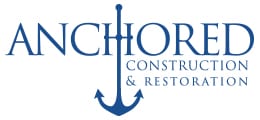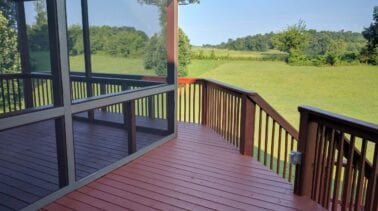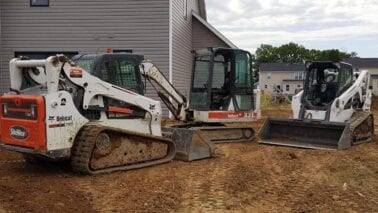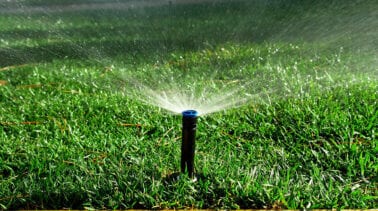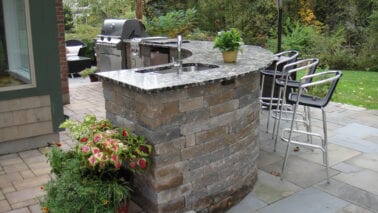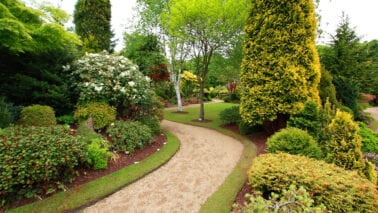Things we are great at…
After over 20 years in business, we’ve learned a thing or two about how to wow our clients on every project. Whether commercial or residential, let us use our knowledge and experience to help bring your ideas to life.
Design and construction of a new deck or pergola, repair of existing structures or adding on to what you already have
Warehouse and Facility Maintenance and Repairs
Pallet racking installation, dock plate levelers, man door installation and repair and more
Installation of new and repair of existing sprinkler systems
Landscape and Plant Installation
Residential and commercial, new installation and renewal of existing installations
Frequently asked questions
Hiring a professional can be beneficial if you aim to transform your outdoor space. Whether you hire a General Contractor or a specialist, a professional knows how to take your vision into reality while avoiding costly pitfalls and making the process as easy and stress free on you as possible. They have the skills and tools necessary to execute complex projects. These projects include elements such as patios, walkways, and retaining walls and full projects such as home additions, outdoor kitchens, pools and pool rooms or an entire home makeover. Their expertise ensures they execute the design complexities right. They also use quality materials, can make helpful recommendations and can offer warranties. The plants selected suit your area’s climate and soil type. All these lead to a more sustainable and pleasing outdoor environment.
The value of hiring a landscaper extends beyond the physical work. These professionals are adept at creating detailed design presentations. They help you visualize the finished product before the actual work begins. This collaborative approach allows adjustments and refinements in the process. Thus ensuring the outcome meets or exceeds your expectations.
Hiring a professional landscaper enhances the beauty of your outdoor space. It also increases its value. The expertise and efficiency that landscapers bring can save you time and money.
Landscaping can improve the value of a home. It enhances its curb appeal and adds functional outdoor living spaces. A well-executed landscaping project can yield a significant return on investment. It often improves the home value by up to 10-20%. This applies to landscaping with patios, outdoor kitchens, and fire pits. These additions make the property more attractive to prospective buyers. They also transform the area into a versatile space. They are suitable for entertainment and relaxation. They make the home stand out in the market.
Landscaping enhancements like a beautiful backyard oasis can become a major selling point. Projects promoting aesthetic appeal and usability contribute to a compelling backyard living project. The best examples are elegant water features and cohesive hardscape designs. These elements invite potential buyers to imagine themselves enjoying the space. In essence, investing in landscaping boosts a property’s aesthetic appeal. It also increases its market value. It makes an excellent consideration for homeowners.
Landscaping refers to the process of modifying the visible features of an area. Modifying the land to create a beautiful design solution. One that enhances the outdoor environment. This can involve a range of activities. It includes plant installation, lawn care, and the construction of outdoor structures.
Landscapers work to integrate natural elements with artificial designs. They ensure that everything fits into the aesthetic of the space. Effective landscaping improves the appearance of a property. It also enhances its functionality. It offers drainage solutions. It prevents water accumulation and promotes healthy vegetation growth.
Also, landscaping can be a creative custom design endeavor. It is a process that transforms your backyard dreams into reality. Professionals use their expertise to craft landscapes. Ones that reflect the homeowner’s personality and needs. Complete landscaping incorporates beautiful and functional elements. They include thematic gardens, natural stone patios, and decorative lighting. Larger projects may include a swimming pool.
Landscaping is about crafting spaces. It could be a simple refresh of an existing yard or a comprehensive overhaul. It is about creating an attractive landscape design in which people want to spend time. This enhancement makes landscaping a pivotal aspect of home improvement and property management.
Landscape design is the art of planning, laying out, and creating outdoor spaces. Landscaping is a beautiful design solution. It enhances the environment and functionality of an area. This discipline involves a detailed process. Design professionals assess the natural features of the land. Then, they apply principles of design. The goal is to create a practical and beautiful living space. Landscape design can range from simple plant arrangements to complex landscaping projects. These projects incorporate various elements. The elements include water features, lighting, and hardscapes like stone walls and patios.
More so, landscape design often entails developing a creative custom design. One that we tailor-fit to transform an ordinary yard into a complete backyard retreat. This personalized approach ensures every element reflects the homeowner’s vision and lifestyle. This process also integrates functional spaces for dining, relaxing, and entertainment. Landscape designers help homeowners use their outdoor space. They do so by focusing on creating a cohesive environment.
Hardscaping and landscaping have distinct components of comprehensive landscape installation. Hardscaping refers to the incorporation of non-living elements into an outdoor space. This includes patios, walkways, retaining walls, and boulder steps. These elements define the hardscape industry.
Hardscaping installations play a crucial role in landscape design. They provide functionality and structure to the garden or yard. These features often serve practical purposes. They include creating pathways, defining spaces, and ensuring soil stabilization. These are essential for the usability and accessibility of outdoor areas.
Meanwhile, landscaping encompasses a broader scope. It includes both hardscaping and the planting of living elements. The goal of landscaping is to create an appealing and functional environment. It combines hardscaping and softscaping (the living components of a landscape). Landscaping is about harmonizing the natural and built environments. It creates a seamless interaction between the two.
Hardscape encompasses several non-living features. We use them in landscape architecture to enhance and structure outdoor spaces. Key elements include paver patios, outdoor kitchens, and water features. They also include outdoor lighting systems. These components are essential for creating functional and beautiful outdoor areas. For instance, paver patios provide a durable and versatile foundation for backyard activities. Outdoor kitchens extend the home’s living space to the outdoors. Also, water features add a serene and captivating element to any garden.
When undertaking hardscape projects, a landscape company often takes an additional step. This ensures that these features integrate with the natural elements of the yard. It is crucial to aim for a cohesive backyard paradise. For example, outdoor lighting enhances the garden’s beauty at night. We craft and install each feature. Thus transforming client projects from basic backyards into luxurious outdoor living areas.
Hardscaping enhances the value of a home. Adding pleasing and functional features to the landscape adds to its worth. A professional landscape company can transform ordinary outdoor spaces into extraordinary ones. With customized design, we guarantee a space that you will love. We provide beautiful installations like stone walkways, retaining walls, and elegant patios. These elements improve the visual appeal of the property. They also make it functional. Thus making it more attractive to potential buyers.
The addition of high-quality hardscaping can increase property value. It also yields a large return on investment. The exact increase can vary. Studies suggest that well-designed outdoor living spaces can add as much as 10-20% to a home’s value.
When considering hardscaping, homeowners should seek out reliable landscape companies. Choose those that deliver excellent quality products at affordable prices. A reputable company ensures that all materials and craftsmanship meet the highest standards. Also, investing in professional design and installation can lead to complete satisfaction. It enhances the enjoyment of the space while living in the home. It also increases its marketability should the owner decide to sell. This strategic approach to hardscaping ensures homeowners receive benefits in aesthetics and functionality. They will also enjoy long-term financial rewards through increased property value.
Hardscape refers to the broader category of non-living elements incorporated into landscape design. It includes stone walls, wooden decks, and custom paver patios. It also includes other structural features made from hard materials. Hardscapes encompass a wide array of installations. They enhance the functionality and aesthetic appeal of outdoor spaces. Thus creating the perfect blend of form and function in your dream space.
Hardscaping Knoxville, TN, is about creating beautiful hardscape features. Ones that can transform a simple backyard into a sophisticated outdoor living area. Hardscaping can include everything from fire pits to water features. All these help improve the usability and enjoyment of outdoor environments.
Meanwhile, paving refers to the process and materials used to lay a flat surface. Paving is often a component of hardscaping. But it focuses on creating surfaces using certain materials. These materials include asphalt, concrete, and premium pavers. A custom paver patio, for example, is a type of paving. It involves placing individual pavers in a specific pattern. It creates a durable and attractive surface. Paving is essential for establishing smooth, stable areas. Paved spaces can handle foot and vehicle traffic.
Finding reliable hardscaping services near you begins with thorough research and recommendations. Start by asking friends, family, or neighbors who had a similar project on their property. Personal referrals can provide trustworthy leads. Checking online review platforms can also give helpful insights. Verifying the company has a license, bond, and insurance is also beneficial.
Once you have a list of potential companies, check their experience and craftsmanship. You can do so by reviewing their portfolios and asking for references. Getting many quotes will help you understand the market rate. It enables you to find a company that fits your budget. Communication is crucial, so choose a company that provides prompt and clear responses.
The costs associated with hardscaping can vary based on several factors. The type of materials used is a significant contributor. Some popular options include concrete, brick, stone, and wood. Each of these materials carries different price points. For example, concrete is less expensive, while natural stone tends to be pricier. The design’s complexity and the landscaped area’s size also impact costs. Simple patios or walkways are cheaper. Intricate features like outdoor kitchens or multi-level terraces are more expensive.
Labor is another significant cost factor. Hardscaping is labor-intensive and often requires skilled craftsmanship. Hiring experienced professionals can increase costs. But it ensures a higher quality and more durable result. Extra expenses include permits, site preparation, drainage solutions, and ongoing maintenance. Budgeting and considering a hardscaping project’s upfront and long-term costs is vital.
The longevity of hardscaping depends on the materials used. The quality of the installation and the level of maintenance provided also plays a role. Generally, well-constructed hardscaping can last 10 to 30 years or more. Hardscaping elements made of natural stone or brick have a longer lifespan. They often exceed 30 years with proper maintenance. Concrete can last a similar amount of time.
Maintenance plays a crucial role in the lifespan of hardscaping. Regular cleaning, sealing, and repairs can extend the life of your hardscaping features. Removing debris, preventing water pooling, and addressing cracks can prevent long-term damage. Proper drainage and avoiding heavy loads on hardscaping elements enhance their durability. The lifespan of hardscaping is a balance of material quality and installation expertise. Ongoing care is another factor to consider.
Yes, hardscaping can increase the value of your home. Hardscaping features like patios, walkways, and retaining walls enhance your property’s aesthetic appeal. It also adds functional outdoor living space. Both are desirable features to potential buyers. Well-designed hardscaping can create a welcoming atmosphere and improve curb appeal. Both influence the perceived value of a home. Elements like outdoor kitchens, fire pits, and water features are attractive. They can make your property stand out in the market.
Hardscaping also contributes to the practical aspects of home value. Proper grading and drainage solutions can prevent water damage and foundation issues. They protect the structural integrity of your home. Hardscaping enhances your property’s enjoyment and marketability. It does so by addressing concerns and creating usable, beautiful outdoor spaces. But, you must ensure that hardscaping uses quality materials and professional installation. Poorly executed projects can have the opposite effect and detract from your home’s value.
Hardscaping uses various materials that create functional and beautiful outdoor spaces. Natural stone is famous for its durability and timeless elegance. It is often used for patios, walkways, and retaining walls. Concrete is another versatile choice. It offers affordability and adaptability through poured concrete or decorative stamped patterns. Concrete is ideal for patios, driveways, and pathways.
Brick and pavers are also popular hardscaping materials. Brick lends a classic, warm appearance to walkways and patios. Meanwhile, pavers offer flexibility in design and easy maintenance. Wood is ideal for elements like decks and pergolas. It requires more maintenance, though.
Materials like gravel and mulch complement these. They are often used for pathways, driveways, and garden beds. They add texture and functionality to hardscaped areas. The choice of materials depends on the project’s desired look, function, and budget.
Maintaining hardscaping for longevity involves regular cleaning, proper care, and preventative measures. Regular cleaning is essential for keeping hardscaping in good condition. This includes sweeping debris off surfaces and power washing. It also involves sealing surfaces where appropriate. Sealing is necessary for natural stone and concrete. It helps protect against moisture penetration, staining, and freeze-thaw damage. Addressing any weeds or moss growing between pavers or stones can prevent displacement. It helps keep your hardscaping looking neat.
Preventative measures play a crucial role in extending the life of hardscaping. You must track cracks, shifting, or drainage issues. Ensure that you address them right away to prevent further damage. Using appropriate de-icing agents in winter can protect surfaces from chemical damage. Avoiding heavy loads or impacts can prevent cracks or breaks. Ensuring proper drainage around hardscaped areas prevents water-related damage. It maintains the integrity of the structures. Regular inspection and on-time repairs ensure your hardscaping remains functional and attractive.
Popular hardscaping designs often combine functionality with aesthetic appeal. They enhance outdoor living spaces in creative ways. Patios are a staple of hardscaping design. They serve as outdoor entertainment areas. We can design them with built-in seating, fire pits, or outdoor kitchens. All these add functionality to the space.
Walkways are another common feature. They guide foot traffic and connect different parts of a landscape. We often incorporate curves or geometric patterns for visual interest.
Retaining walls are functional and add an attractive element to a landscape. They help manage sloping terrain and create distinct garden areas. Water features like fountains, ponds, and waterfalls are also popular. They add a soothing ambience to outdoor spaces. Also, driveways and courtyards offer practical and stylish hardscaping options. They often feature intricate designs or patterns to enhance curb appeal.
Yes, it is possible to do hardscaping on a budget. The key is to plan and hire a reliable hardscaping contractor. Using cost-effective materials is another factor to consider. During planning, define the scope and prioritize the most critical elements. Focusing on one project at a time allows you to control costs while enhancing your outdoor space.
Choosing affordable materials can also help keep costs down. For example, using gravel or concrete pavers instead of natural stone reduces expenses. While cheaper, it creates the same attractive hardscaping feature. Tackling some or all the work can save on labor costs. You can also do simple projects like installing a gravel path or building a basic fire pit. But, it is vital to recognize your skill level. Seek professional help for more complex tasks to avoid costly mistakes. You can create hardscaping on a budget with careful planning and material selection.
Choosing the right hardscaping contractor is crucial. This ensures a successful project that meets your expectations. Start by researching potential contractors in your local area. Then, gather recommendations from friends or family. Choosing a contractor with a solid reputation and customer satisfaction is essential. Checking online reviews can provide insight into other customers’ experiences. Additionally, verify that the contractor has licenses, bonds, and insurance. Having these protects you in case of accidents or issues during the project.
Also, check the contractor’s experience and expertise in hardscaping. Look for a portfolio of completed projects that align with your vision. Clear communication is vital. Thus, select a contractor who listens to your needs and answers your questions. Your contractor should also provide a detailed contract. It should outline the scope of work, timeline, and costs.
Hardscaping contractors offer various services to enhance outdoor spaces. One of their primary services is the design and installation of patios and decks. Both create comfortable outdoor living areas. Hardscaping contractors also specialize in constructing walkways and driveways.
Another critical service offered by hardscaping contractors is the installation of retaining walls. These walls serve functional and decorative purposes. They help manage sloping terrain, prevent soil erosion, and create level areas. Hardscaping contractors often design and build outdoor kitchens and outdoor fireplaces. All these enhance the usability and enjoyment of outdoor spaces. Other services may include creating water features, fences, gazebos, and pergolas. All these add structure and privacy to outdoor areas. Hardscaping contractors offer services to transform outdoor spaces into functional, attractive home extensions.
The cost of hiring a hardscaping contractor varies. They vary based on several factors, including:
- the scope and complexity of the project,
- the materials used, and
- the contractor’s rates.
Basic hardscaping projects like small patios or walkways cost up to $5,000. Elaborate projects like outdoor kitchens and retaining walls can cost $50,000 or more. The type of materials chosen also impacts the total cost. Options like natural stone are more expensive than concrete or brick.
Labor costs are a significant component of hardscaping expenses. They often constitute 50% to 70% of the total project cost. Hiring a reputable contractor with a strong track record may come at a premium. But it often ensures a higher-quality result. Additional costs include permits, design services, and site preparation. Hiring a hardscaping contractor can cost a lot, but the investment can enhance your outdoor living space. It increases the value of your home.
Choosing the best local hardscaping contractor near you involves careful research and evaluation. Start by gathering recommendations from family or friends. Additionally, use online resources to identify reputable contractors in your area. Look for local contractors with high ratings and positive feedback. These state a history of satisfied customers.
Once you have a list of potential contractors, verify their credentials. Ensure that the contractor has licenses, bonds, and insurance. This protects you in case of accidents or issues during the project. Next, check the contractor’s experience and expertise. Look for a portfolio of past projects that align with your vision. Ask for references to gauge previous clients’ satisfaction.
Also, choose a contractor who communicates well. Good communication is critical to a successful project. Finally, ensure that the contract is clear. It should outline the scope of work, timeline, and costs to avoid misunderstandings. Following these steps, you can choose the best hardscaping contractor near you.
Hardscaping can last several decades. Its longevity depends on the materials used and the quality of the installation. You also need to factor in the maintenance level. Generally, well-constructed hardscaping features can last 10 to 30 years or more. For instance, structures made of natural stone or brick often have a lifespan of over 30 years.
Meanwhile, concrete features with proper maintenance can last a similar amount of time. These materials resist the elements. They can withstand significant wear and tear with proper installation.
Maintenance plays a crucial role in the lifespan of hardscaping. Regular cleaning, sealing, and repairs can extend the life of these features. Removing debris, preventing water pooling, and addressing cracks can prevent long-term damage. Ensuring proper drainage and avoiding heavy loads or impacts can enhance their durability. With appropriate care, hardscaping can remain functional and beautiful for many years. It makes a worthwhile investment in your outdoor space.
Yes, many eco-friendly options are available for hardscaping. They enhance the aesthetics of outdoor spaces and promote sustainability. One popular choice is using permeable paving materials. This includes porous concrete, permeable pavers, and decomposed granite. These materials allow water to seep through the surface into the ground below. They reduce runoff and prevent erosion while replenishing groundwater levels.
Another approach involves using recycled or reclaimed materials for hardscaping projects. We can use reclaimed wood, recycled glass, and repurposed stone or bricks. These materials reduce environmental impact. They reduce waste and the need for new raw materials. Additionally, selecting local materials reduces transportation emissions associated with the hardscaping project. Thus further contributing to environmental sustainability.
Another sustainable hardscaping strategy is incorporating living elements. This includes green roofs and living walls. These features help insulate buildings, improve air quality, and support urban biodiversity. Moreover, using drought-tolerant and native plants in landscape design reduces water usage. They also reduce maintenance needs.
Popular hardscaping materials encompass a range of durable and aesthetic choices. Each is suitable for different styles and functional requirements. Natural stone is a top choice due to its durability and timeless appeal. Natural stone offers unique colors and textures, making each hardscaping project distinct. Concrete is another favored material, appreciated for its versatility and cost-effectiveness. We can use it in its basic form or modified through staining and stamping to mimic other materials.
Brick is famous for its classic look and warmth. It adds an inviting ambiance to outdoor spaces. It is famous for its longevity and ease of repair. Pavers made from concrete, stone, or clay offer excellent customization options. They are easy to replace if damage occurs, making them ideal for high-traffic areas.
Additionally, we use wood for decks and structures. It brings a natural and rustic element to garden designs. For eco-conscious choices, recycled materials are gaining popularity. They provide sustainable options that help reduce environmental impact.
Weather plays a significant role in the planning and maintenance of hardscaping projects. The impact of weather starts from the construction phase. Heavy rain can delay projects by making the ground too wet for work. Extreme temperatures can also affect concrete curing and the comfort of working conditions.
Once we install hardscaping elements, ongoing weather conditions influence their longevity and appearance. Freeze-thaw cycles are particularly impactful. Water seeps into cracks and can freeze and expand. Thus causing further cracking and structural damage over time. Sun exposure can fade materials like wood and some types of stone. Meanwhile, excessive moisture can promote the growth of moss, algae, and weeds. These can degrade materials and need frequent cleaning.
Proper planning is vital. Selecting materials adapted to local climate conditions can mitigate many of these issues. Regular maintenance, like sealing surfaces and repairing cracks, is crucial. They ensure that hardscaping withstands the test of time against weather conditions.
Yes, many hardscaping contractors offer free estimates as a standard service. Providing a free estimate is a common practice in the industry. It allows homeowners to understand the potential costs without any financial commitment. During an estimate, a contractor visits the property. We discuss the project details and assess the site. Then, we calculate the projected costs. We base it on the scope of work, materials required, and labor involved.
It’s beneficial for homeowners to get estimates from many contractors. This lets you compare prices, services, and the contractor’s expertise. It also allows one to gauge each contractor’s professionalism and communication style. Both are crucial factors in choosing the right one for the job. While most estimates are free, it’s always good to confirm this first.
The timeline for a hardscaping project varies depending on its scope and complexity. We can complete small projects like a simple patio or walkway within a few days to a week. But, larger and more intricate projects can take weeks to months.
Several factors influence the duration of a hardscaping project. The preparation phase includes designing, obtaining necessary permits, and preparing the site. It can affect the timeline. Weather conditions also play a crucial role. Adverse weather can delay work, especially tasks that need dry conditions. The availability of materials and the contractor’s schedule can also impact the timeline.
Discussing the timeline with your hardscaping contractor is best. It helps you to get a realistic estimate of the project’s duration. They can provide a more accurate schedule. They base it on their assessment of the project’s requirements. It also includes any external factors that may influence the duration of the work.
Preparing your outdoor space for hardscaping involves several vital steps. It ensures the area is ready for construction and the structure will be durable.
First, clear the project area of any debris, vegetation, or existing structures. Next, check and improve the drainage of the region. Adequate drainage is essential to prevent water accumulation. Consider grading the soil to encourage water runoff away from hardscape areas. Also, integrate extra drainage solutions like French drains.
Before you begin digging, it’s crucial to identify and mark any underground utilities. This helps avoid disruptions and accidents. Your local utility companies do the task for free. Also, prepare the base where your hardscape will lie. This might involve leveling the ground, compacting the soil, or adding a layer of sand or gravel. It helps create a stable and level foundation. Proper foundation preparation prevents future shifting or cracking of your hardscape materials. Consulting with a professional can provide valuable insights into optimizing your preparation process. They can also help you choose suitable materials and designs for your needs.
